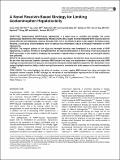| dc.contributor.author | Patel, Suraj J | en_US |
| dc.contributor.author | Luther, Jay | en_US |
| dc.contributor.author | Bohr, Stefan | en_US |
| dc.contributor.author | Iracheta-Vellve, Arvin | en_US |
| dc.contributor.author | Li, Matthew | en_US |
| dc.contributor.author | King, Kevin R | en_US |
| dc.contributor.author | Chung, Raymond T | en_US |
| dc.contributor.author | Yarmush, Martin L | en_US |
| dc.date.accessioned | 2016-05-02T16:59:30Z | |
| dc.date.issued | 2016 | en_US |
| dc.identifier.citation | Patel, Suraj J, Jay Luther, Stefan Bohr, Arvin Iracheta-Vellve, Matthew Li, Kevin R King, Raymond T Chung, and Martin L Yarmush. 2016. “A Novel Resolvin-Based Strategy for Limiting Acetaminophen Hepatotoxicity.” Clinical and Translational Gastroenterology 7 (3): e153. doi:10.1038/ctg.2016.13. http://dx.doi.org/10.1038/ctg.2016.13. | en |
| dc.identifier.issn | 2155-384X | en |
| dc.identifier.uri | http://nrs.harvard.edu/urn-3:HUL.InstRepos:26860020 | |
| dc.description.abstract | Objectives: Acetaminophen (APAP)-induced hepatotoxicity is a major cause of morbidity and mortality. The current pharmacologic treatment for APAP hepatotoxicity, N-acetyl cysteine (NAC), targets the initial metabolite-driven injury but does not directly affect the host inflammatory response. Because of this, NAC is less effective if given at later stages in the disease course. Resolvins, a novel group of lipid mediators shown to attenuate host inflammation, may be a therapeutic intervention for APAP hepatotoxicity. Methods: The temporal patterns of liver injury and neutrophil activation were investigated in a murine model of APAP hepatotoxicity. In addition, the effect of neutrophil depletion and resolvin administration on the severity of liver injury induced by APAP was studied. In vitro studies to investigate the mechanism of resolvin effect on hepatocyte injury and neutrophil adhesion were performed. Results: We demonstrate that hepatic neutrophil activation occurs secondary to the initial liver injury induced directly by APAP. We also show that neutrophil depletion attenuates APAP-induced liver injury, and administration of resolvins hours after APAP challenge not only attenuates liver injury, but also extends the therapeutic window eightfold compared to NAC. Mechanistic in vitro analysis highlights resolvins' ability to inhibit neutrophil attachment to endothelial cells in the presence of the reactive metabolite of APAP. Conclusions: This study highlights the ability of resolvins to protect against APAP-induced liver injury and extend the therapeutic window compared to NAC. Although the mechanism for resolvin-mediated hepatoprotection is likely multifactorial, inhibition of neutrophil infiltration and activation appears to play an important role. | en |
| dc.language.iso | en_US | en |
| dc.publisher | Nature Publishing Group | en |
| dc.relation.isversionof | doi:10.1038/ctg.2016.13 | en |
| dc.relation.hasversion | http://www.ncbi.nlm.nih.gov/pmc/articles/PMC4822092/pdf/ | en |
| dash.license | LAA | en_US |
| dc.title | A Novel Resolvin-Based Strategy for Limiting Acetaminophen Hepatotoxicity | en |
| dc.type | Journal Article | en_US |
| dc.description.version | Version of Record | en |
| dc.relation.journal | Clinical and Translational Gastroenterology | en |
| dash.depositing.author | Patel, Suraj J | en_US |
| dc.date.available | 2016-05-02T16:59:30Z | |
| dc.identifier.doi | 10.1038/ctg.2016.13 | * |
| dash.contributor.affiliated | Luther, Jay | |
| dash.contributor.affiliated | Patel, Suraj | |
| dash.contributor.affiliated | King, Kevin Robert | |
| dash.contributor.affiliated | Li, Matthew | |
| dash.contributor.affiliated | Chung, Raymond | |
| dash.contributor.affiliated | Yarmush, Martin | |


